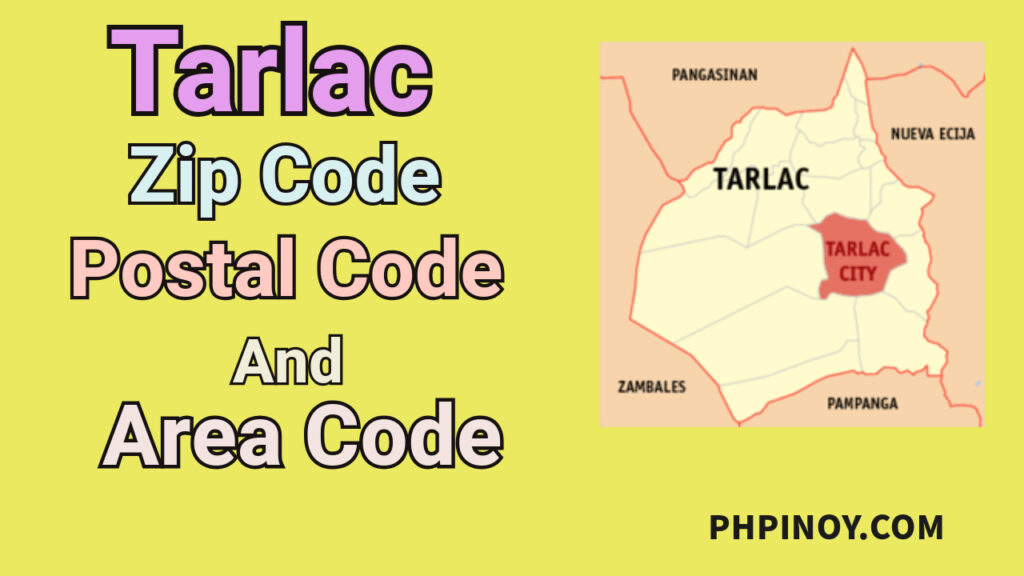Tarlac is known as the “Melting Pot of Central Luzon.” It is one of the multi-cultural provinces as it consists of different ethnic groups, such as Tagalogs, Ilocanos, Pangasinans, and Kapampangans. This province is also notable for sugar, fine food, and rice plantations. The provinces that surround it are Pangasinan on the north, Nueva Ecija on the east, Pampanga on the south, and Zambales on the west. It has also been a destination for historical landmarks, eco-tourism, natural scenery, and unique adventure spots.
Tarlac ZIP Codes, Postal Codes, and Area Code
Here are the postal codes (zip codes) and area codes of one component city and seventeen municipalities in Tarlac. The range of postal codes (zip codes) of Tarlac is 2300 – 2318, and the area code is 045.
| City / Municipality | Postal Code / Zip Code | Area Code |
| Anao | 2310 | 045 |
| Bamban | 2317 | 045 |
| Camiling | 2306 | 045 |
| Capas | 2315 | 045 |
| Concepcion | 2316 | 045 |
| Gerona | 2302 | 045 |
| La Paz | 2314 | 045 |
| Mayantoc | 2304 | 045 |
| Moncada | 2308 | 045 |
| Paniqui | 2307 | 045 |
| Pura | 2312 | 045 |
| Ramos | 2311 | 045 |
| San Clemente | 2305 | 045 |
| San Jose | 2318 | 045 |
| San Manuel | 2309 | 045 |
| Sta. Ignacia | 2303 | 045 |
| Tarlac | 2300 | 045 |
| Victoria | 2313 | 045 |
Key Areas of Tarlac
These are some key areas of Tarlac that contributed significantly to the development of its various sectors, such as tourism, industries, and the economy. Each of these areas has its unique food, culture, and sceneries that make Tarlac unique and special.
1. Tarlac City. It is located in the center of the province, making it the capital of Tarlac. The languages used by its locals are Kapampangan, Pangasinan, Ilocano, and Tagalog. One of the notable celebrations in this city is the Malatarlak Festival. The “Magkaisa Bawat Oras Sama Sama!” is the shared motto of this progressive and vibrant city.
2. Paniqui. A first-class municipality located in the north-central part of Tarlac. Its topography is described as hilly on the western side, and the rest are flatlands. Its main economy lies in the agriculture sector. Its tourist attractions include the Saint Rose of Lima Church, Paniqui Sugar Mills, parks, and other wonderful destinations.
3. Conception. One of the largest municipalities in Tarlac. The Lucong and Parua rivers are two of the iconic rivers in the municipality. The tourist attractions in the province consist of the Aquino Family Ancestral House, Santuario de la Immaculada Conception, and more. The native languages used by its locals are Kapampangan, Tagalog, and Ilocano.
4. Capas. Known as the “Tourism Capital of Tarlac,” this municipality is home to various historical destinations. It is also iconic for Mount Pinatubo treks, a place visited by many tourists. This is also where Capas National Shrine, an obelisk with a central bell, is located. There are also other attractions, such as mountains, trails, a hanging bridge, hot springs, and a lake.
5. Camiling. It has a rich cultural heritage, as there are ancestral houses, churches, and ruins in the area. The two famous foods in this town are chicharon Camiling and nilubayan, a green native rice cake. It also hosts the ‘Iniruban and Chicharon Festival,” which showcases its culture, traditions, and products, as well as the talents of the locals.
FAQs
What is special about Tarlac?
There are many things that are special about Tarlac, such as its native delicacies, lively festivals, cultural heritage, tourist attractions, and natural sceneries.
What is the main source of income in Tarlac?
The main source of income in Tarlac comes from the agricultural sector.
What is the most famous festival in Tarlac?
The Malatarlak Festival is the most famous festival in Tarlac Province. There are also other well-known festivals, such as Belenismo sa Tarlac and Chicharon Iniruban Festivals.
